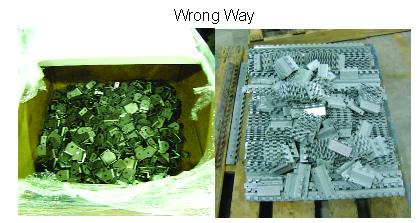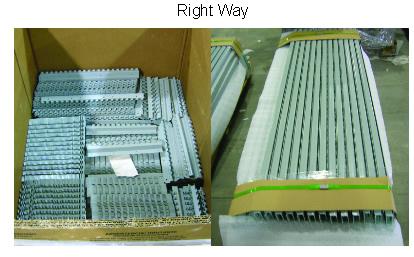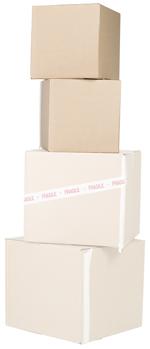- FMA
- The Fabricator
- FABTECH
- Canadian Metalworking
Categories
- Additive Manufacturing
- Aluminum Welding
- Arc Welding
- Assembly and Joining
- Automation and Robotics
- Bending and Forming
- Consumables
- Cutting and Weld Prep
- Electric Vehicles
- En Español
- Finishing
- Hydroforming
- Laser Cutting
- Laser Welding
- Machining
- Manufacturing Software
- Materials Handling
- Metals/Materials
- Oxyfuel Cutting
- Plasma Cutting
- Power Tools
- Punching and Other Holemaking
- Roll Forming
- Safety
- Sawing
- Shearing
- Shop Management
- Testing and Measuring
- Tube and Pipe Fabrication
- Tube and Pipe Production
- Waterjet Cutting
Industry Directory
Webcasts
Podcasts
FAB 40
Advertise
Subscribe
Account Login
Search
Packaging finished stampings
Protecting parts so they don't end up scrap
- By Greg Yahn
- July 10, 2007
- Article
- Materials Handling
Editor's Note: This article is adapted from Greg Yahn's conference presented at FABTECH® International & AWS Welding Show, Nov. 13-16, 2005, Chicago, Ill.,© 2005 by the Fabricators & Manufacturers Association Intl. (FMA), the Society of Manufacturing Engineers (SME), and the American Welding Society (AWS).
One of the most frustrating problems a fabricator can face is the waste of a perfectly good part because the finish has been marred or damaged in shipment. Worldwide, damage of finished product costs companies millions of dollars each day in both direct and indirect costs.
Proper packaging is an essential part of the manufacturing process that often is overlooked. It not only saves the cost of damaged goods, but it also can decrease the cost of incorrect product counts, which can be a major headache for manufacturers of stampings.
The Need for Finishing
Each day hundreds of millions of metal parts, from tiny washers to large appliance components, are stamped and formed to meet rigid customer requirements all around the world.
For many products, forming the metal is only the beginning of the process. Once the parts have been made, they often require a specific finish. This finish may be a primer coat to protect the part for further assembly, or it may be a final finish the part will wear throughout its life cycle.
The finish may be to protect the metal from corrosion caused by exposure to chemicals or the outdoor environment. The finish may be to insulate the product from electrical current. It may even be just to make the product look good. In any case, a lot of time and money have been spent to get the product to the stage at which a finish is to be applied.
The finishing process may be done in-house at the company's own finishing facility, or it may be outsourced to an outside finishing vendor. The finish can be liquid paint, plating, e-coating, powder coating, enamel coating, or even polishing and buffing.
Typical Challenges
When finishing is complete, the product is ready to be moved to its next phase. At that point two questions must be answered:
- What is the best way to protect the finished product from damage until its next operation?
- How can product count accuracy be ensured?
Unfortunately, these are two of the least-asked questions in the history of manufacturing.
While this is a problem for companies with in-house finishing, it is even more of a challenge for companies that outsource finishing. When a company sends product out for finishing, it expects to receive the same number of pieces back, finished correctly and in good shape. Too often what the company receives from the finisher is fewer parts than it shipped out, with a percentage of the returned parts damaged beyond repair or, at the very least, requiring touchup.

Figure 1Throwing parts into a cardboard box or onto a skid that is falling apart increases the chance of part damage during shipment.
Communication problems, misread prints, and quality control issues aside, the most common culprit is poor packaging. But this blame should not be entirely placed on the finisher. Too often the customer is most interested in the price of finishing only, giving no consideration to packaging.
Obviously, some product is easily nested and stacked, making it fairly simple for the finisher to repack the parts the way they came in. However, more often than not, the parts are shipped to the finisher in bulk, thrown or piled in a Gaylord container or on a skid, and the burden of the packaging is on the finisher. This can be a recipe for disaster!
Let's say that a customer sends ABC Finishing some stamped parts that are thrown in a cardboard box on a skid that is falling apart (seeFigure 1). How is ABC going to return those parts? In the same oil-stained box? On the same broken skid? And if ABC wraps the parts in paper and nests them in a new box on a new skid, shrink-wraps them, and bands them to the skid, was that in the original quoted price? Is ABC also responsible for disposal of the soiled cardboard and the junk skid?
These are questions that need to be asked proactively. The finishing company cannot be responsible for providing packaging materials and supplies unless it is included in the original quoted price, and preferably on a separate line item. And will that added cost put the finisher out of competition for the bid?
Finally, the finishing process is not always 100 percent acceptable. Sometimes a few rejected products are not detected until a production run is over. They cannot always be refinished and included with the shipment, especially if the order is being done just-in-time.
This means that some lagging product will need to be included with the next shipment or be sent along after the fact. Because of the nature of the volumes associated with most stamping operations, this count variance is not as important as incorrect counts of product.
If ABC Finishing has some stragglers that need to catch up with the order because of quality control issues, that generally is not a problem. The problem occurs when the paperwork says the shipment has 100 pieces, but it really has only 97. The stamping company may not be able to complete an order because of this, and a costly tracking and rework/replacement process begins.
If ABC is drop-shipping finished product to the stamping company's customer and sends 104 pieces instead of 100, are those parts being paid for? Packaging can be a blessing or a curse when it comes to count accuracy.
True Cost of Poor Packaging
What does it matter if stamped and formed product isn't packaged properly? So what if the counts are off by one or two pieces? How much can it cost?
In fact, the intangible costs of damaged finished product can be astounding. Depending on the part in question, the cost to identify, return, strip, refinish, re-return, reinspect, and replenish can be as much as it would be to make and finish several dozen parts properly.

Figure 2Many types of packaging are available to protect finished product. The simplest and most versatile packaging materials are paper, plastic foam, and cardboard.
The labor and rework to fix a part that has only a damaged finish may cost more than replacing the part entirely. This does not include the cost of phone calls, paperwork, and time to track one or two pieces through the entire process. In essence, the cost of improper packaging can eat up all the profit of a job, and it is almost entirely preventable.
When it comes to inaccurate counts, the effects can be just as costly, if not more. A customer who at least has damaged product might be able to make an acceptable repair. A customer who doesn't have the parts at all is simply out of luck.
In many cases, the finisher is the last stop for the product en route to the final customer or the assembly operation, which may be states away from the stamping company and the finisher. If the number of parts shipped does not meet the required amount, an entire assembly line may shut down until the replacement parts can be provided. This usually means rush charges, liquidated damages, express shipping, and penalties for the ultimate part provider. This is not good!
The entire contract, as well as the company's reputation, may be at stake. This, of course, is an extreme example, but it does happen. And most of it can be avoided with proper packaging.
Packaging Options
If a stamper is going to send product to an outside finisher, it needs to discuss packaging in detail. It should make sure the finisher knows exactly what is required and that how the parts will be shipped there is as clear as how parts will be shipped back.
Many types of packaging are available to protect finished product (seeFigure 2). Some packaging systems also can help ensure that the proper numbers of parts are in each container.
The type of product material (such as steel, stainless steel, aluminum, or copper) can have an impact on the packaging choice. Weight is an important factor that may affect how many pieces can be packaged together without resulting in damage.
Does the product have sharp edges that will cut through the packaging? Are there threaded studs or pins that may bend, break off, or scratch other parts? Can reusable packaging be used, or do the parts dead-end with the customer? These are some of the questions that should be asked.
Other variables include the volume of parts per order, the frequency of orders, and the flow of the product.
The simplest and most versatile packaging materials are paper, plastic foam, and cardboard. For products that nest easily, simple craft paper between parts may suffice. For stackable products, cardboard and plastic foam are efficient and affordable.
Making sure that the skid or container is rigid and sufficient to handle the weight is important. Many times using plastic stretch wrap in combination with banding secures a skid as well as any specialized rigid container will.
It is important to take into consideration how far the load must travel, and how it will be shipped. Twenty miles down the highway in the company truck will result in fewer jolts than state to state on a common carrier with several transfers. Common sense should play a significant role in these decisions.
Some possible solutions for difficult products are plastic bags made from material thick enough to prevent rubbing or puncturing, self-adhesive foam pads, air bags, foam peanuts, and shredded paper. For some products with very awkward geometries, egg crating may be best. Egg crating also helps ensure that there is a consistent number of parts per container. All the operator has to do is make sure that each space has a good egg in it.
For some products, a completely custom container is the only solution. This packaging helps protect the products best while minimizing the per-piece cost of the packaging.
The ideal situation involves a large number of products that are released in consistent, repetitive quantities with a product flow that allows reusable containers. Reusable packaging allows the stamping company to maximize the use of the packaging and the efficiency of using it.
If packaging is not reusable, the customer will have to dispose of it. It may be easy for the finisher to wrap a customer's parts in plastic wrap, but the customer will then have a mountain of plastic to deal with when unwrapping parts for assembly.
Reaching the Goal Together
The goal is to find the very best way to protect the product during shipment without spending unnecessary dollars, and to ensure that the packaging contributes to efficient production while ensuring accurate counts.
Each job will have its own set of constraints and parameters, and it is up to both the stamper and the finisher to work together to make sure that they understand this. Stamping and finishing great-quality product is only half of the game. The other half is to make sure that the customer receives great-quality finished product, in its entirety.
About the Author
Greg Yahn
7401 Klier Drive
Fairview, PA 16415
814-474-5200
subscribe now

The Fabricator is North America's leading magazine for the metal forming and fabricating industry. The magazine delivers the news, technical articles, and case histories that enable fabricators to do their jobs more efficiently. The Fabricator has served the industry since 1970.
start your free subscription- Stay connected from anywhere

Easily access valuable industry resources now with full access to the digital edition of The Fabricator.

Easily access valuable industry resources now with full access to the digital edition of The Welder.

Easily access valuable industry resources now with full access to the digital edition of The Tube and Pipe Journal.
- Podcasting
- Podcast:
- The Fabricator Podcast
- Published:
- 04/16/2024
- Running Time:
- 63:29
In this episode of The Fabricator Podcast, Caleb Chamberlain, co-founder and CEO of OSH Cut, discusses his company’s...
- Industry Events
16th Annual Safety Conference
- April 30 - May 1, 2024
- Elgin,
Pipe and Tube Conference
- May 21 - 22, 2024
- Omaha, NE
World-Class Roll Forming Workshop
- June 5 - 6, 2024
- Louisville, KY
Advanced Laser Application Workshop
- June 25 - 27, 2024
- Novi, MI
































